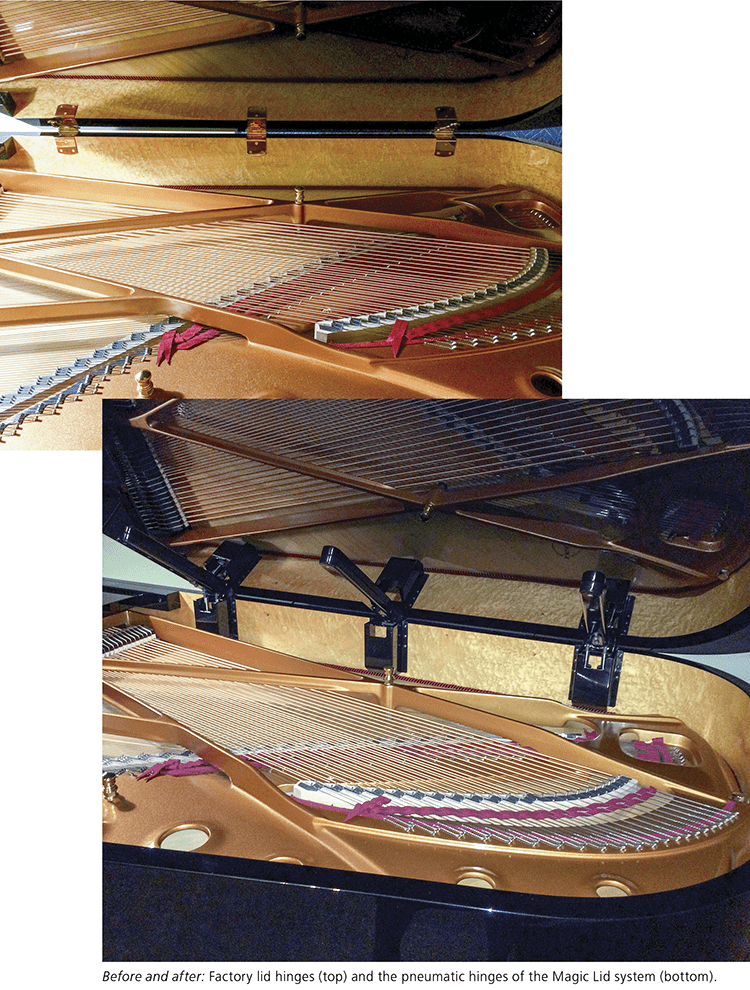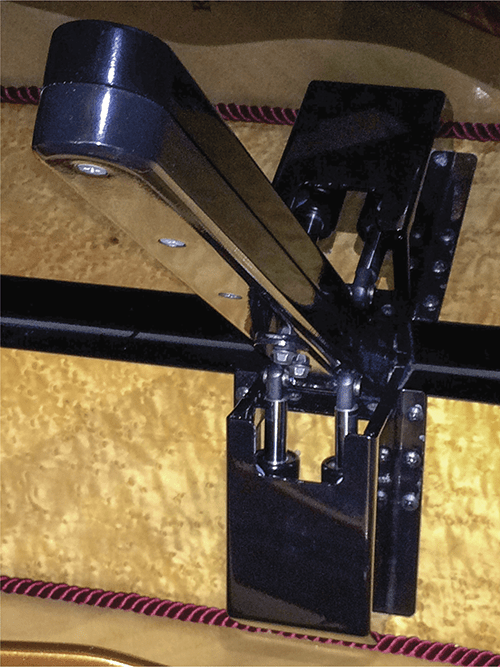It's been with great interest, therefore, that I've followed, over the last few years, the introduction into the marketplace of the Magic Lid pneumatic slow-close system for grand-piano lids. Magic Lid promises to make this precarious, heavy part of a piano safer and easier to use for people of all ages, heights, and degrees of physical strength. My own story illustrates its usefulness.
In early spring of 2014, I sold my 6' grand piano and began a search for a 7' replacement. However, while unhooking my old piano's humidity-control system in preparation for shipping the instrument from Wisconsin to its new owner in Cincinnati, I injured myself — a pinched nerve in my spine that resulted in shoulder pain and tingling fingers on one hand. By mid-summer, following medical treatment, exercise, and care not to repeat the same physical movements that triggered the pain, the symptoms had subsided, and I was able to resume my search for a new piano.
I was generally satisfied with my final choice, but for one aspect: Like many Asian and European grand pianos (including some very fine brands) whose lids are made of medium-density fiberboard (MDF) or very dense hardwoods and are covered with a polyester finish, my new piano's lid was extremely heavy and hard to lift — a problem that my recent injury made only worse.
Soon after buying the new piano, I changed jobs, which necessitated a move from Wisconsin to Georgia and made possible my first foray into home ownership. Looking forward to finally having a living room large enough to let me play my 7' grand with its lid fully open without disturbing the neighbors, and given the injury I'd recently sustained, I nevertheless was not enthusiastic about having to frequently raise and lower this leviathan of a lid. I therefore used the occasion of the move to arrange for my piano to make an intermediate stop at PianoWorks, in Atlanta, Georgia (www.pianoworks.com), where I purchased and had installed the Magic Lid system.

Despite some trepidation about witnessing the performance of major surgery on my precious new instrument, I chose to attend the installation. Piano Technology Retail Support (PARS), Magic Lid's owner and global distributor, was kind enough to fly in their VP of Product Development Paul Rea and Danny Geoghegan, a technician and inventor of Magic Lid, to personally install the system, answer my questions, and train the PianoWorks staff.
The installation took about three hours in a fully equipped shop space, and required one or two helpers at various points in the process. They began by removing the piano's lid, and the three original lid hinges from the rim and lid. Next, three shallow notches were routed out in the top of the rim to accommodate the new brackets and hinges containing the pneumatic cylinders that provide the mechanism's lifting and braking forces. New holes were discreetly and carefully drilled in the lid for the supports that attach the lid to the pneumatic cylinders. Along the way, Geoghegan used many tracings, jigs, checks, and rechecks to ensure that everything would line up perfectly when the parts were reassembled.
After reinstalling the lid on its new hinges, a couple of rounds of adjustments were performed to obtain the desired lifting strength for the pneumatic cylinders. (The amount of lift can be adjusted, both during and after installation.) The technician can choose to install four or six cylinders, depending on the piano's length; the installer can then adjust the angles of the cylinders for more or less lift to customize the system's response to the owner's needs. The process concluded with a good amount of cleaning of fingerprints and sawdust from in, on, and around the piano.
As it turned out, for this installation training session, my piano received the type of Magic Lid system supplied in a factory installation: the original lid hinges are replaced with ones containing the pneumatic cylinders. In a normal retrofit of an existing piano, however, the original lid hinges are retained, and a box containing two cylinders is placed on the rim in the space between the hinges. Unlike the factory-installed version, which requires the piano surgery described above, the retrofit version requires virtually no modification of the piano, and the system can be removed if desired. But because it uses fewer cylinders and is mounted differently, it supplies less force and operates a little less smoothly than the factory-installed version. According to the distributor, the cost of a factory-installed Magic Lid varies depending on the manufacturer's labor charge, but typically totals about $1,500. The retrofit version, a simpler installation done by a local dealer or technician, retails for $735.

Closeup of pneumatic lid hinge
During and after the installation, I interviewed Magic Lid's inventor, Danny Geoghegan, and PARS's CEO, Basilios Strmec, about the Magic Lid system. According to Geoghegan, Magic Lid was inspired by a terrible accident that occurred in his shop:
Back in 2008, an elderly woman was in my store shopping for a 4' 8" baby grand, and she wanted to see how it looked with the lid closed. She tried to close the lid by herself, but lost control of it, and it slammed shut and crushed four fingers of her hand, which was resting on the piano's rim. I learned that way how dangerous the piano lid can be for people who aren't strong enough to handle it, and started to think about how to prevent an accident like this from happening again.
Since I hold several invention patents in pianos and organs, the first thing I did was to conduct a search of the U.S. Patent Office files. What a surprise! It turned out that there were many patents filed over the years related to this matter — the first one was dated 1882 — but none ever made it to the marketplace. So I began working on a lid-support system: calculating the forces involved; considering materials, space limitations, minimum cosmetic changes, etc. One of the biggest challenges was finding a manufacturer that could build the gas spring cylinders to my specifications.
From this research, I built a retrofit system that could be installed in any existing grand piano with minimal modification to the instrument. This system was so successful with customers that I decided to design a system that could be built into new pianos at the factory.
When asked how long a Magic Lid system will last, Geoghegan said that, if made and installed according to his specifications, it should last the life of the piano. "The system doesn't weaken the lid or rim of the piano, and in the thousands of installations that have been done so far, there have been no problems reported. In addition, in laboratory testing, the cylinders performed well up to at least 36,000 strokes — it would take almost 100 years of opening and closing the lid once a day to reach that many strokes. However, for safety's sake, we recommend that the cylinders be checked every five years. If the system ever needs new cylinders, they can be easily replaced at nominal cost."
I asked CEO Strmec about the Magic Lid's target market:
Our key markets are families with small children, and committed pianists. Safety is a major concern with families, and should be. The often very heavy piano lid poses a danger for younger and elderly users. Committed pianists — those who play regularly — are the second group. While one might imagine a scenario in which the lid comes crashing down, the reality is that most injuries from opening and closing the piano lid come in the form of strained muscles, or too much pressure on shoulders and backs. These soft-tissue injuries that almost every pianist is familiar with can have a huge impact on practice and performance. This new technology also puts pressure on music schools to protect their students by procuring pianos with Magic Lid installed, and we believe this will be a major market in the future.
Strmec added that the near future will see the launch of Magic Lid 2, which will allow a piano's lid to remain open in any position the user desires. As the lid acts as a sound modulator, and its position nuances how the sound is projected, Magic Lid 2 will give the user unprecedented control over the piano's volume and projection of sound.
The Magic Lid retrofit kit can be installed on almost any grand piano, and is purchased through an authorized dealer or technician who has been specially trained to install it.
The factory-installed version is a standard feature globally on all Hailun grand pianos, as well as on Cunningham grands and some Baldwin grand models. PARS has also approached a number of other manufacturers about installing the Magic Lid system in their new pianos on special request. Currently, the manufacturers that are familiar with the product and its installation include Brodmann, Kawai, Mason & Hamlin, Petrof, Sauter, Steinway, and Yamaha. Those desiring a factory-installed system on a piano from one of these makers will require their approval, and should begin by contacting PARS.
Having had the Magic Lid system installed on my piano for a few weeks now, as well as a year teaching in a keyboard lab with a new grand outfitted with the system as original equipment at the factory, I can add a few other comments and tips that may be of interest to potential owners:
With Magic Lid installed, as currently adjusted, lifting my piano's lid to its fully open position now feels as if it requires only about half the effort as before. The mechanism's braking/lifting force appears greatest as the lid approaches the piano's rim, which perhaps explains why lifting the lid to the partially open ("half-stick") position now feels exceptionally easy — requiring about 75% less effort than without Magic Lid.
It's still possible to remove the lid of your piano after the Magic Lid system is installed. The lid must be opened until it is perpendicular (90°) to the floor, with another person or two present to help lift it straight up, off the hinges. This allows for future rebuilding of the instrument, as well as the ability to use the piano in nontraditional stage setups, such as a "nested" configuration (curved sides facing each other) for two-piano performances.
Moving a piano with the Magic Lid system installed is not a problem, but you should tell your mover about it so that proper measures can be taken to keep the lid closed during transport — it has a tendency to open due to the fact that, when the piano is on its side for moving, the gravitational force that normally counters the lifting force of the pneumatic cylinders is not in play. Similarly, if your piano's lid has no lock, you may need to lightly place one hand on the main lid while opening the front, or "fly," lid. Otherwise, the main lid is likely to rise as you open the fly.
Magic Lid has made opening and closing the lid of my piano really easy — and fun. The lid closes slowly and gently as it reaches the rim, virtually eliminating the possibility of injury to me or the piano. I still find myself intentionally dropping the lid from its fully opened position — just to watch Magic Lid perform!
For more information about ordering the Magic Lid slow-close piano-lid system for a new or existing grand piano, or to find a local authorized installer, contact PARS at 509-946-8078 or admin@vienna-pianos.com.